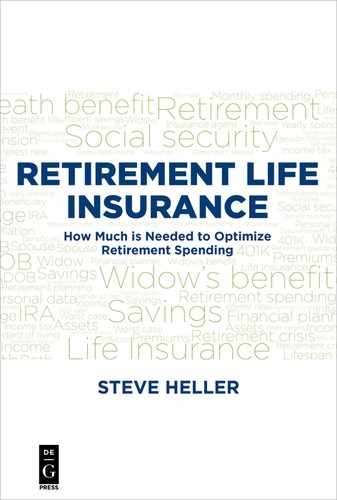0%
29Chapters
0-1Hours read
0kTotal Words
Table of Contents
- Cover
- Title Page
- Copyright
- Acknowledgments
- Contents
- Preface
- Chapter 1: The Retirement Crisis in Brief
- Chapter 2: A New Use for Life Insurance
- Chapter 3: A Visit with the Financial Planner
- Back to Our Two Sisters…
- The Comparison between Results with and without Insurance
- How is the Amount of Life Insurance Calculated?
- Including Existing Life Insurance
- Optimizing the Timing of Social Security
- Entering Client Personal Data
- Entering Client Asset Data
- Entering Client Income Information
- Full Retirement Age and the Primary Insurance Amount
- Estimating Sustainable Spending before Adding Insurance
- When to Take Social Security
- Annuities or Pensions
- Expected Additional Expenses
- Sustainable Spending Including Additional Expenses
- Indexing for Inflation
- Existing Life Insurance
- Assumptions on Inflation and Return on Investments
- The Social Security Optimization after Setting the Assumptions
- How Much Life Insurance Would Optimize Sustainable Spending?
- What is Sustainable Spending?
- Another Look at the Comparative Results with and without Life Insurance
- Back to Our Two Sisters…
- Chapter 4: Another Visit with the Financial Planner
- Year Numbers
- Cash
- Nominal vs. Real Return
- The Need for an Annual Review
- Traditional Retirement Account Assets
- Withdrawal Strategies to Optimize Taxes
- Four Different Withdrawal Strategies
- Other Ways to Improve Sustainable Spending
- Significant Improvements in Sustainable Spending by Adding Insurance
- Roth Assets
- Taxable Assets
- Taxable Assets Basis
- Estimating Taxes vs. Precise Tax Calculations
- Chapter 5: The Withdrawal Source Section of the Spreadsheet
- Chapter 6: Cash, Taxes, and Insurance Premiums The Next Day…
- Chapter 7: Calculating Sustainable Retirement Spending
- A Very Simplified Example of the Sustainable Income Calculation
- Chapter 8: Adding an Annuity
- Chapter 9: Can an Annuity Improve Sustainable Retirement Spending?
- Where to Find Annuity Payment Information
- Why Knowing the Exact Starting Dates of an Annuity is Important
- Deferred Annuities Can Also Improve Sustainable Retirement Spending
- What Happens after the Death of One or Both Annuitants?
- Adjusting Annuity Payments to CPI
- Why we Might Want to Compare Last Year’s Projections with this Year
- Worst Case Longevity Results
- Median Longevity Results
- The Worst Case Years of Death
- Selecting the Starting Date for Life Insurance
- Appendix A: Reference Manual for the Gui Interface of the Rhino Retirement Analyzer V1.0, Basic Mode
- The Opening Screen
- The Personal Data Tab
- The Assets Tab
- The Income Tab
- Salary
- The Annuities or Pensions Tab
- The Expected Additional Expenses Tab
- The Existing Life Insurance Tab
- The Assumptions Tab
- The Suggested Insurance Tab
- The Suggested Annuities Tab
- Other Features of the GUI Main Screen
- Saving, Reloading, and Clearing Data
- Appendix B: Reference Manual for the GUI for the Rhino Retirement Analyzer v1.0, Expert Mode
- Appendix C: Tutorial for the Scripting Language and Command-Line Interface of the Rhino Retirement Analyzer v1.0
- Why does the Rhino Retirement Analyzer Need a Command-Line Interface and a Scripting Language?
- The rra File Type: Initializing the Program with Previously Saved Data
- A Command-Line Example
- A Sample rra Script File
- A Sample File Header
- The Variable Assignment Portion of the Sample Script File
- The Function Execution Portion of the Sample rra File
- Other Options for Command-Line Use
- The rrr File Type: Recording a Run of the Program for Later Replaying
- Uses for the .rrr File Type
- Appendix D: The Market for Retirement Spending Optimization
- Appendix E: The Genesis of the Rhino Retirement Analyzer (and this Book)
- Appendix F: What is Included, What is Excluded, and Known Limitations of the Program
- Index
